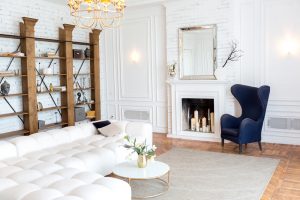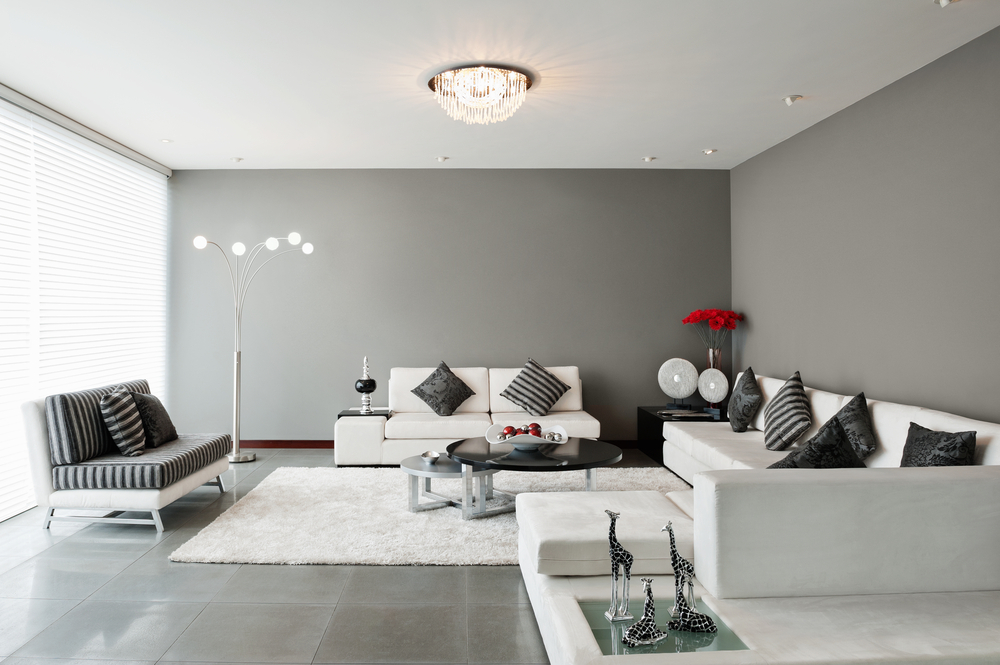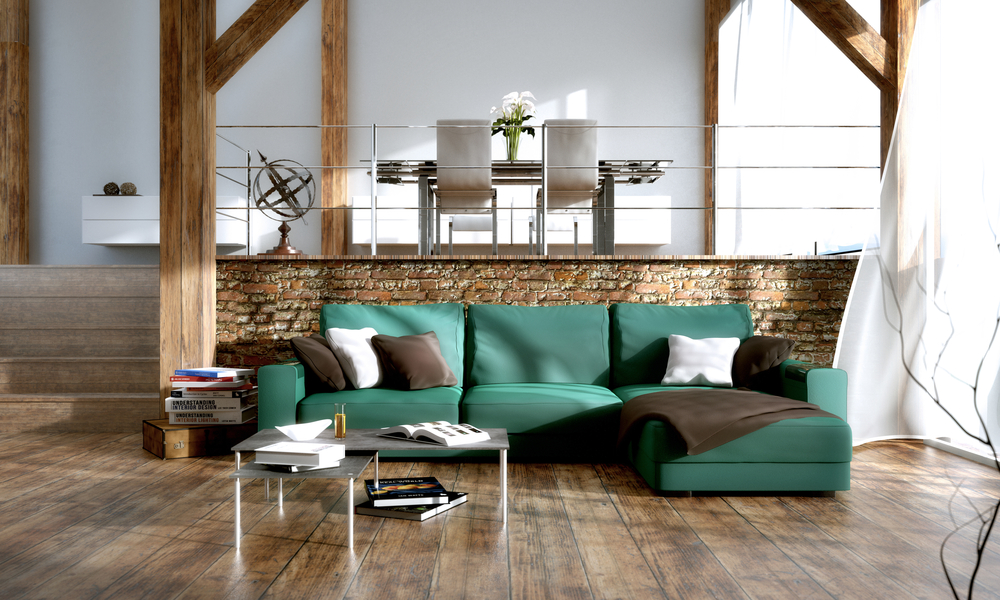Color Pointers for Painting Your Living Room

You’ve probably thought about changing the color of your living room walls before, or maybe you’ve asked yourself which shades are the best for them? We’ll give you some pointers today in our post for your living room walls.
First off, we need to remember that the living room is the most frequented space of a house and it’s a place that we’ll always use when we invite over company. So, we should offer a nice presentation and a comfortable space.
Tranquility
Warm or earthy colors can help calm the atmosphere of your living room. Not all colors can offer tranquility. Intense red, for example, doesn’t bring peace, but rather, livens up the area and gives it energy.
What do we have to do to achieve a tranquil atmosphere? An ochre, beige, or maroon palette gives off elegance and peace in addition to being a little daring. Furthermore, these colors pair well with furniture.
However, other colors that aren’t warm can transmit a sense of tranquility. For example, blues can help open your mind but try to avoid light or strong blue tones.

Rest and security
If you’re looking for a restful and secure ambiance, green is the perfect color because it offers peace and ease. Green can transport you to nature and the outdoors, which gives a timeless feeling.
However, green can be a tricky color to match, which is why you should opt for green only if you’re aiming for a bold and dynamic living room. Green will inspire a state of relaxation.
What shades of green match well? Emerald and light green are good options; they’re both are great for wall color. If you want to pair the colors with white, you can paint one wall with an intenser shade of green.
Peace and purity
White is the best color for providing peace and purity. It’s the most popular shade for homes and public spaces; it has a considerable presence in society.
The advantage of using white is that it offers brightness, light and it feels clean. It never saturates a space nor does it weigh the mood down; it is subtle and peaceful.
White works to help all of your furniture pieces or decorative elements fit better in a room. Using white won’t only impact your personal feelings, but it calms a room’s atmosphere.
Is off-white okay, too? To some extent, yes. Off-white offers opacity and brightness, but you should ensure that there’s natural light that illuminates all of the walls directly.
Elegance
There are a lot of instances in which neutral colors can help develop a sense of elegance. There are colors, such as gray, that can help turn your walls into a frame that reinforces the decor.

A gray tone, regardless of whether it’s light or dark, is a great option for highlighting the design elements of a room.
Similar to white, gray doesn’t stand out, making it a functional color that’s easy to combine with other elements. It’s a neutral color.
Despite having received a lot of criticism in the world of interior design for being a boring color, gray transmits positivity. With decoration, you can switch up the monotone look of a space.
Gray tones can depress the ambiance of a room, which is why using captivating decorative pieces is key. However, an effective furniture layout can also enrich a room’s atmosphere, even if the colors are a little dim.
Combining color and materials
Don’t forget that combining various resources can create an aspect of dynamism and a change in design approaches.
What are the possible options? One idea is using a white tone and combining it with brick. Applying this combination is simple – use a brick wall and paint the rest of the walls white.

Another idea is combining white with stone. For example, green, white, maroon, yellow, etc. – all of these colors can be a perfect match to create harmony.
You can use stone however you like, whether it’s masonry or overlapping stones. An interesting idea is trying black or cream-colored stone with colors.
Conclusion
There are multiple ways to paint your living room walls. It all depends on you and the ambiance that you want to transmit. However, you should remember to balance the decoration and color.
Prepare your project well and know what kind of feeling you want your living room to have. Make sure you choose your colors carefully because they’ll determine the feeling that you’ll have every time you step into the room.
You’ve probably thought about changing the color of your living room walls before, or maybe you’ve asked yourself which shades are the best for them? We’ll give you some pointers today in our post for your living room walls.
First off, we need to remember that the living room is the most frequented space of a house and it’s a place that we’ll always use when we invite over company. So, we should offer a nice presentation and a comfortable space.
Tranquility
Warm or earthy colors can help calm the atmosphere of your living room. Not all colors can offer tranquility. Intense red, for example, doesn’t bring peace, but rather, livens up the area and gives it energy.
What do we have to do to achieve a tranquil atmosphere? An ochre, beige, or maroon palette gives off elegance and peace in addition to being a little daring. Furthermore, these colors pair well with furniture.
However, other colors that aren’t warm can transmit a sense of tranquility. For example, blues can help open your mind but try to avoid light or strong blue tones.

Rest and security
If you’re looking for a restful and secure ambiance, green is the perfect color because it offers peace and ease. Green can transport you to nature and the outdoors, which gives a timeless feeling.
However, green can be a tricky color to match, which is why you should opt for green only if you’re aiming for a bold and dynamic living room. Green will inspire a state of relaxation.
What shades of green match well? Emerald and light green are good options; they’re both are great for wall color. If you want to pair the colors with white, you can paint one wall with an intenser shade of green.
Peace and purity
White is the best color for providing peace and purity. It’s the most popular shade for homes and public spaces; it has a considerable presence in society.
The advantage of using white is that it offers brightness, light and it feels clean. It never saturates a space nor does it weigh the mood down; it is subtle and peaceful.
White works to help all of your furniture pieces or decorative elements fit better in a room. Using white won’t only impact your personal feelings, but it calms a room’s atmosphere.
Is off-white okay, too? To some extent, yes. Off-white offers opacity and brightness, but you should ensure that there’s natural light that illuminates all of the walls directly.
Elegance
There are a lot of instances in which neutral colors can help develop a sense of elegance. There are colors, such as gray, that can help turn your walls into a frame that reinforces the decor.

A gray tone, regardless of whether it’s light or dark, is a great option for highlighting the design elements of a room.
Similar to white, gray doesn’t stand out, making it a functional color that’s easy to combine with other elements. It’s a neutral color.
Despite having received a lot of criticism in the world of interior design for being a boring color, gray transmits positivity. With decoration, you can switch up the monotone look of a space.
Gray tones can depress the ambiance of a room, which is why using captivating decorative pieces is key. However, an effective furniture layout can also enrich a room’s atmosphere, even if the colors are a little dim.
Combining color and materials
Don’t forget that combining various resources can create an aspect of dynamism and a change in design approaches.
What are the possible options? One idea is using a white tone and combining it with brick. Applying this combination is simple – use a brick wall and paint the rest of the walls white.

Another idea is combining white with stone. For example, green, white, maroon, yellow, etc. – all of these colors can be a perfect match to create harmony.
You can use stone however you like, whether it’s masonry or overlapping stones. An interesting idea is trying black or cream-colored stone with colors.
Conclusion
There are multiple ways to paint your living room walls. It all depends on you and the ambiance that you want to transmit. However, you should remember to balance the decoration and color.
Prepare your project well and know what kind of feeling you want your living room to have. Make sure you choose your colors carefully because they’ll determine the feeling that you’ll have every time you step into the room.







